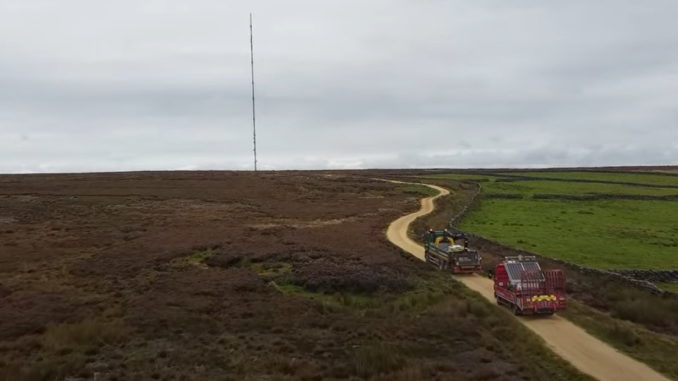
A study into the potential impact of a temporary mast to provide a television signal for hundreds of thousands of homes has concluded the scheme has a range of potential consequences for England’s largest continuous tract of heather moorland.
The 80-metre high emergency transmitter is scheduled to be switched on tomorrow, with the final engineering work and power tests due to take place today, more than two months after the 314m Bilsdale transmitter caught fire.
The mast’s owners Arqiva say the temporary mast will serve 95 per cent of 600,000 homes across Teesside, County Durham and North Yorkshire with 70 Freeview channels.
However, work to examine how it affects the 44,082-hectare North York Moors Special Area of Conservation and designated Site of Special Scientific Interest it is sited on is set to continue for years.
Due to the pressing nature of the scheme work has been allowed to get underway while concerns for the site are examined.
While large-scale planning applications often attract a host of objections fron nearby residents, Arqiva’s scheme application to the North York Moors National Park Authority seeking planning consent for the steel structure has been backed by some nearby residents.
In a submission to the the North York Moors National Park Authority one couple wrote: “Even though we live on the private access road to the transmitters and expect some disruption, we have no objections to the application.
“It is our view that it is important for people who have lost services to get their TV reception back as soon as possible.
“This is particularly important for elderly people who have suffered enough during the current Covid pandemic.”
An ecology study submitted on behalf of Arqiva concludes the project has “potential for damage and therefore loss of extent of qualifying natural habitat”.
It highlights how the fragile ecosystem could suffer following trampling of vegetation and soil compaction, chemicals, fuel and from the pouring of concrete and other materials into the soil.
The study states there is “potential for disturbance or loss of extent of qualifying natural habitat during process which may disturb or displace nesting birds or dependent young and damage nests” of birds such as golden plover and curlew.
The study also found the scheme may disturb or displace nesting birds or dependent young and damage nests and raised concerns over potential chemical spillages and ingestion by birds.
A report lodged with the authority states: “Significant excavations are anticipated to be necessary as part of the project. In total it is anticipated that
300 tonnes of soils may be removed from the site to facilitate the construction of the staging area and foundation. It is anticipated that this excavation may have an impact upon local hydrology…”
The study found the loss of of habitat would have “short-term adverse effects but will not adversely affect site integrity given the small area of land involved” for the tower and the temporary nature of the tower. It added the area affected is very small in comparison with the total Special Area of Conservation.
It adds options are being developed for a “strategic compensation measure” to ensure a long-term benefits are secured for the North York Moors to take account of the total effect on habitats by the temporary mast before the installation of a permanent mast replacement.
To counter the concerns mitigation and remedial measures have been proposed to ensure the construction of the new tower within the protected site results in minimal impact upon the dry heaths.
To oversee this an ecological clerk of works will look for opportunities to identify and remediate any adverse impacts during construction, operation, and decommissioning of the mast and during the recovery phase.
The report concludes: “There is a strong and urgent public interest in establishing continuity of coverage to those affected by the Bilsdale Transmitter fire. Many thousands of people will benefit from the coverage provided by the proposed development where the effects are demonstrated to be reversible…”


Be the first to comment